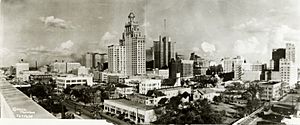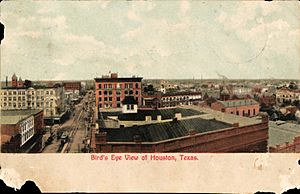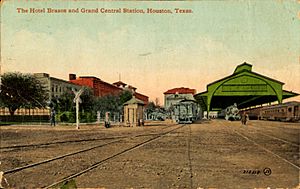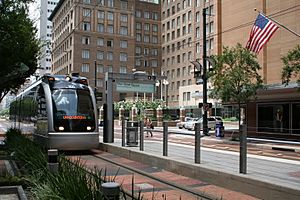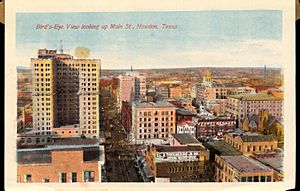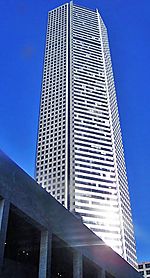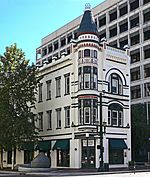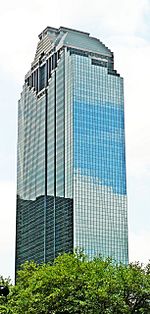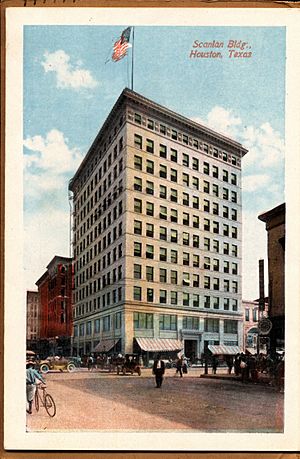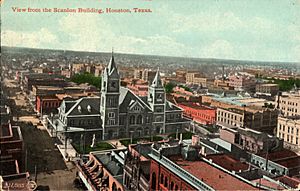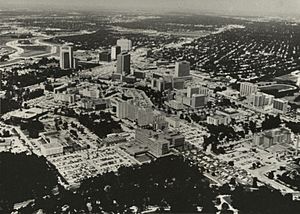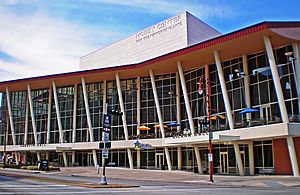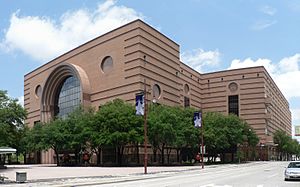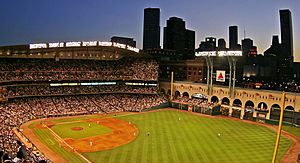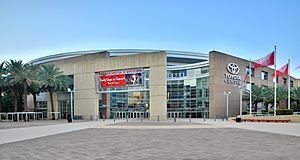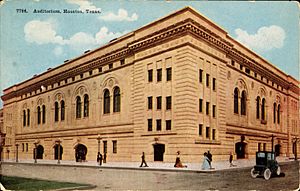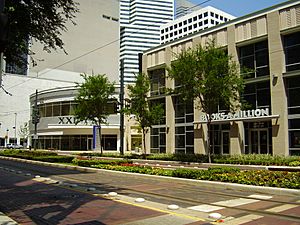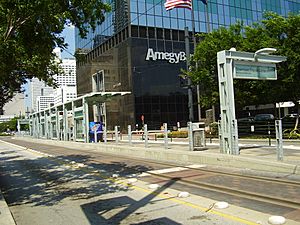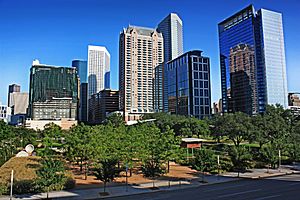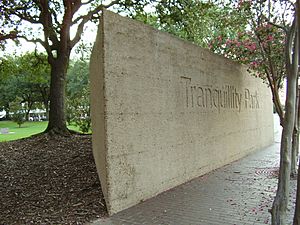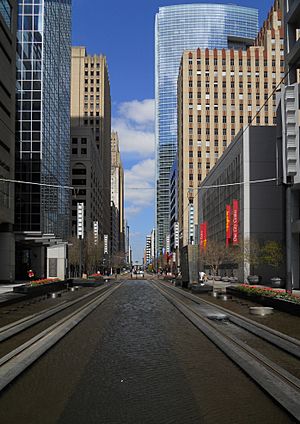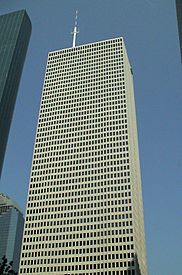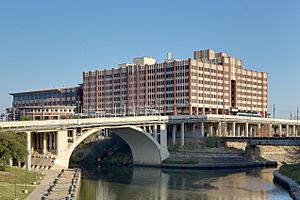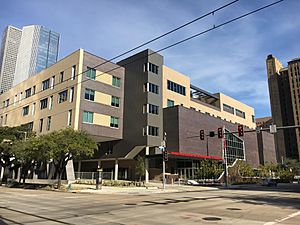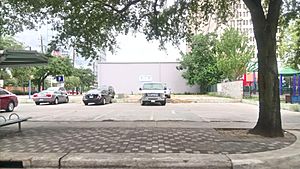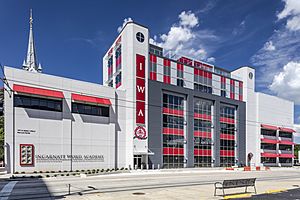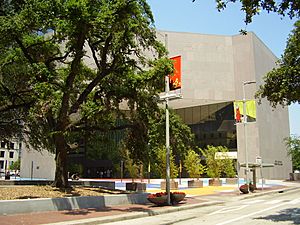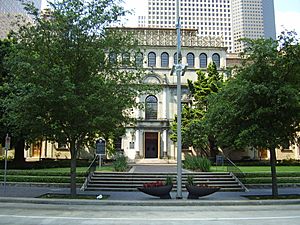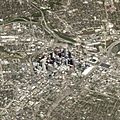Downtown Houston facts for kids
Quick facts for kids
Downtown Houston
|
|
|---|---|
|
Neighborhood of Houston
|
|
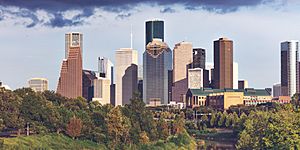
The Downtown skyline from the west.
|
|
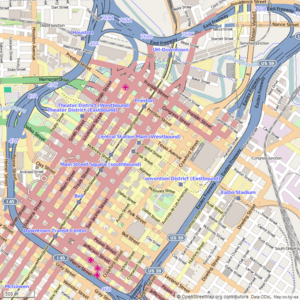
Road map of Downtown Houston.
|
|
| Country | |
| State | |
| County | Harris County |
| City | |
| Settled | 1836 |
| Subdistricts | |
| Area | |
| • Total | 4.8 km2 (1.84 sq mi) |
| Population
(2017)
|
|
| • Total | 10,165 |
| • Density | 2,133/km2 (5,524/sq mi) |
| Greater Downtown (within 2 miles): 74,791 | |
| ZIP Code |
77002
|
| Area code(s) | 281, 346, 713, and 832 |
Downtown is the largest business district in the city of Houston and the largest in the state of Texas, located near the geographic center of the metropolitan area at the confluence of Interstate 10, Interstate 45, and Interstate 69. The 1.84-square-mile (4.8 km2) district, enclosed by the aforementioned highways, contains the original townsite of Houston at the confluence of Buffalo Bayou and White Oak Bayou, a point known as Allen's Landing. Downtown has been the city's preeminent commercial district since its founding in 1836.
Today home to nine Fortune 500 corporations, Downtown contains 50 million square feet (4,600,000 m2) of office space and is the workplace of 150,000 employees. Downtown is also a major destination for entertainment and recreation. Nine major performing arts organizations are located within the 13,000-seat Theater District at prominent venues including Alley Theatre, Hobby Center for the Performing Arts, Jones Hall, and the Wortham Theater Center. Two major professional sports venues, Minute Maid Park and the Toyota Center, are home to the Houston Astros and Houston Rockets, respectively. Discovery Green, an urban park located on the east side of the district adjacent to the George R. Brown Convention Center, anchors the city's convention district.
Downtown is Houston's civic center, containing Houston City Hall, the jails, criminal, and civil courthouses of Harris County, and a federal prison and courthouse. Downtown is also a major public transportation hub, lying at the center of the light rail system, park and ride system, and the metropolitan freeway network; the Metropolitan Transit Authority of Harris County (METRO) is headquartered in the district. Over 100,000 people commute through Downtown daily. An extensive network of pedestrian tunnels and skywalks connects a large number of buildings in the district; this system also serves as a subterranean mall.
Geographically, Downtown is bordered by East Downtown to the east, Third Ward to the south, Midtown to the southwest, Fourth Ward to the west, Sixth Ward to the northwest, and Near Northside to the north. The district's streets form a strict grid plan of approximately 400 square blocks, oriented at a southwest to northeast angle. The northern end of the district is crossed by Buffalo Bayou, the banks of which function as a linear park with a grade-separated system of hike-and-bike trails.
Contents
History
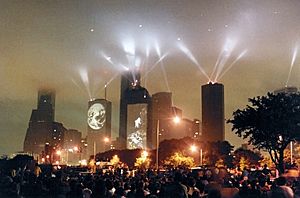
Downtown Houston was the original founding point of the city. After the Texas Revolution, two New York real estate promoters, John Kirby Allen and Augustus Chapman Allen, purchased 6,642 acres (2,688 ha) of land from Thomas F.L. Parrot and his wife, Elizabeth (John Austin's widow), for $9,428. The Allen brothers first landed in the area where the White Oak Bayou and Buffalo Bayou meet, a spot now known as Allen's Landing. Gail Borden, Jr., a city planner, laid out wide streets for the town.
The city was granted incorporation by the Texas legislature on June 5, 1837. Houston was the temporary capital of Texas. In 1840, the town was divided into four wards, each with different functions in the community. By 1906 what is now Downtown was divided among six wards. The wards are no longer political divisions, but their names are still used to refer to certain areas.
Downtown's growth can be attributed to two major factors: The first arose after the Galveston Hurricane of 1900, when investors began seeking a location close to the ports of Southwest Texas, but apparently free of the dangerous hurricanes that frequently struck Galveston and other port cities. Houston became a wise choice, as only the most powerful storms were able to reach the city. The second came a year later with the 1901 discovery of oil at spindletop, just south of Beaumont. Shipping and oil industries began flocking to east Texas, many settling in Houston. From that point forward the area grew substantially, as many skyscrapers were constructed, including the city's tallest buildings. In the 1980s, however, economic recession canceled some projects and caused others to be scaled back, such as the Bank of the Southwest Tower.
In the 19th century much of what was the Third Ward, the present day east side of Downtown Houston, was what Stephen Fox, an architectural historian who lectured at Rice University, referred to as "the elite neighborhood of late 19th-century Houston." Ralph Bivins of the Houston Chronicle wrote that Fox said that area was "a silk-stocking neighborhood of Victorian-era homes." Bivins said that the construction of Union Station, which occurred around 1910, caused the "residential character" of the area to "deteriorate." Hotels opened in the area to service travelers. Afterwards, according to Bivins, the area "began a long downward slide toward the skid row of the 1990s" and the hotels devolved into flophouses. Passenger trains stopped going to Union Station in 1974. The construction of Interstate 45 in the 1950s separated portions of the historic Third Ward from the rest of the Third Ward and brought those portions into Downtown.
Beginning in the 1960s the development of the 610 Loop caused the focus of the Houston area to move away from Downtown Houston. Joel Barna of Cite 42 said that this caused Greater Houston to shift from "a fragmenting but still centrally focused spatial entity into something more like a doughnut," and that Downtown Houston began to become a "hole" in the "doughnut." As interchange connections with the 610 Loop opened, according to Barna Downtown "became just another node in a multi-node grid" and, as of 1998, "has been that, with already established high densities and land prices." In the mid-1980s, the bank savings and loan crisis forced many tenants in Downtown Houston buildings to retrench, and some tenants went out of business. Barna said that this development further caused Downtown Houston to decline.
The Gulf Hotel fire occurred in 1943.
On April 5, 1986, the entire Downtown area was transformed as part of a concert by French musician Jean Michel Jarre. Called Rendez-Vous Houston, the open-air show used the skyscrapers as giant projection screens, and as launchpads for fireworks. The show celebrated 25 years of NASA, 150 years of Texas, and was a tribute to the astronauts killed in the recent Challenger Disaster. The show attracted a then-record live audience of 1.3 million people.
Areas which are, as of 2009, considered to be a part of Downtown Houston were once considered to be within the Third Ward and the Fourth Ward communities; the construction of Interstate 45 in the 1950s separated the areas from their former communities and placed them in Downtown. Additional freeway construction in the 1960s and 1970s formed the current boundaries of Downtown. Originally, Downtown was the most important retail area of Houston. Suburban retail construction in the 1970s and 1980s reduced Downtown's importance in terms of retail activity. By 1987 many of the office buildings in Downtown Houston were owned by non-U.S. real estate figures. The Texas Legislature established the Downtown Houston Management District in 1995.
The arrival of major industry also saw the advent of skyscrapers in Houston. The building boom of the 1970s and 1980s saw the erection of major buildings, many of them ranking as the tallest in the state and the nation.
More recently, the Downtown Living Initiative provided economic and other development incentives for developers to build new multifamily residential mixed-use developments in Downtown in an attempt to attract more.
Composition
Downtown Houston is a 1,178-acre (1.841 sq mi) area bounded by Interstate 45, Interstate 69/U.S. Highway 59, and Interstate 10/U.S. Highway 90. Several districts exist in Downtown Houston. They include:
- Warehouse – Home to Houston’s alternative art scene, unique dining options, live music, artists’ studios and downtown’s first lofts.
- Historic – This was the original town center of Houston and dates from the 19th century. The center of the historic district is the Market Square, where the original city hall building stood.
- Harris County – The district includes the Harris County courts complex, and the University of Houston–Downtown is on the edge of the district.
- Ballpark – Includes Minute Maid Park and surrounding restaurants, lofts, and office space.
- Convention – Includes the George R. Brown Convention Center, Discovery Green, the Toyota Center, and some of the largest hotels in the city.
- Skyline – Includes many skyscrapers and forms the base of Downtown's employment. The buildings are connected by the extensive underground tunnel network.
- Shopping – Main Street Square has a pavilion and fountains built around the Main Street Square Station – GreenStreet and the Shops at Houston Center are in the area.
- Theater – The 17 block area includes many performing arts venues, Bayou Place, and the Houston Aquarium restaurant
- Civic Center – Contains the core of Houston's government, including City Hall – the Houston Public Library Central Library is also here,
- Medical – Includes St. Joseph Medical Center, residential properties and the Sacred Heart Co-Cathedral campus.
By the late 1980s, 35% of Downtown Houston's land area consisted of surface parking. n Houston. By the end of 1999, the number was expected to increase to almost 2,000 units.
Most of the residential units in downtown are conversions of older buildings into modern loft spaces. The lofts are located around the performance halls of the Houston Theater District and near Main Street in the Historic District. In spring 2009, luxury high-rise One Park Place opened-up with 346 units.
Developers have invested more than 4 billion US$ in the first decade of the 21st century to transform downtown into an active city center with residential housing, a nightlife scene and new transportation. January 1, 2004 marked the opening of the "new" Main Street, a plaza with many eateries, bars and nightclubs, which brings many visitors to a newly renovated locale.
Phoenicia Specialty Foods opened a downtown grocery store in 2011.
Demographics
In 2017 the Downtown Super Neighborhood #61, which includes Downtown and East Downtown, had 12,879 people. 34% were non-Hispanic White, 28% were Hispanic, 32% were non-Hispanic Black, 4% were non-Hispanic Asians, and 2% were non-Hispanic people of other racial identities.
In 2015 there were 12,407 residents. 33% were non-Hispanic White, 32% were non-Hispanic Black, 29% were Hispanic, 5% were non-Hispanic Asian, and 1% were non-Hispanics of other racial identities.
In 2000 there were 12,407 residents. 5,083 (41%) were non-Hispanic Black, 4,225 (34%) were non-Hispanic White, 2,872 (23%) were Hispanic, 156 (1%) were non-Hispanic Asians, 56 were of two or more races, 11 were non-Hispanic American Indian, and two each were non-Hispanic Native Hawaiian and non-Hispanic people of other racial identities.
Architecture
In the 1960s, downtown comprised a modest collection of mid-rise office structures, but has since grown into one of the largest skylines in the United States. In 1960, the central business district had 10 million square feet (930,000 m²) of office space, increasing to about 16 million square feet (1,500,000 m²) in 1970. Downtown Houston was on the threshold of a boom in 1970 with 8.7 million square feet (800,000 m²) of office space planned or under construction and huge projects being launched by real estate developers. The largest proposed development was the 32-block Houston Center. Only a small part of the original proposal was ultimately constructed, however. Other large projects included the Cullen Center, Allen Center, and towers for Shell Oil Company. The surge of skyscrapers mirrored the skyscraper booms in other cities, such as Los Angeles and Dallas. Houston experienced another downtown construction spurt in the 1970s with the energy industry boom.
The first major skyscraper to be constructed in Houston was the 50-floor, 218 m (714 ft) One Shell Plaza in 1971. A succession of skyscrapers were built throughout the 1970s, culminating with Houston's tallest skyscraper, the 75-floor, 305 m (1,002 ft) JPMorgan Chase Tower (formerly the Texas Commerce Tower), which was completed in 1982. In 2002, it was the tallest structure in Texas, ninth-tallest building in the United States, and the 23rd tallest skyscraper in the world. In 1983, the 71-floor, 296 m (970 ft) Wells Fargo Plaza was completed, which became the second-tallest building in Houston and Texas, and 11th-tallest in the country. Skyscraper construction in downtown Houston came to an end in the mid-1980s with the collapse of Houston's energy industry and the resulting economic recession.
Twelve years later, the Houston-based Enron Corporation began constructing a 40-floor, 1,284,013sq.ft skyscraper in 1999 (which was completed in 2002)
Notable buildings
Notable buildings that form Houston's downtown skyline:
- The Sweeney, Coombs, and Fredericks Building is a late Victorian commercial building with a 3-story corner turret and Eastlake decorative elements that was designed by George E. Dickey in 1889. Evidence indicates that the 1889 construction may have been a renovation of an 1861 structure built by William A. Van Alstyne and purchased in 1882 by John Jasper Sweeney and Edward L. Coombs. Gus Fredericks joined the Sweeney and Coombs Jewelry firm before 1889. The building is on the corner of Main Street and Congress Street at 301 Main Street. The jewelry firm is still in business. It is one of the very few Victorian structures in the Bayou City.
- The Gulf Building, now called the JPMorgan Chase building, is one of the preeminent Art Deco skyscrapers in the southern United States. Completed in 1929, it remained the tallest building in Houston until 1963, when the Exxon Building surpassed it in height.
- The Esperson Buildings, 'Neils' built in 1927 and 'Mellie' in 1942, were modeled with Italian architecture.
- The Houston City Hall was started in 1938 and completed in 1939. The original building is an excellent example of the Art Deco Era. In front of City Hall is the George Hermann Square.
- One Shell Plaza was, at its completion in 1971, the tallest building in Houston. It stands 715 feet (218 m) tall, and when the antenna tower on its top is included, the height of One Shell Plaza is 1,000 feet (300 m).
- Houston Public Library's Central Library, consists of two separate buildings: the Julia Ideson Building (1926) and the Jesse H. Jones Building (1976).
- The Houston Industries Building, formerly known as the 1100 Milam Building, was built in 1973. It went through major renovations in 1996.
- Pennzoil Place, designed by Philip Johnson, built in 1976, is Houston's most award winning skyscraper, known for its innovative design. Johnson's forward thinking brought about a new era in skyscraper design.
- The First City Tower was built in 1981.
- The JPMorgan Chase Tower, designed by I.M. Pei, was built in 1981. Formerly the Texas Commerce Tower, it is the tallest in Houston and the second tallest in the United States west of the Mississippi River.
- The Chevron Tower, formerly the Gulf Tower, was built in 1982.
- The Bank of America Center, formerly the RepublicBank Center and the NationsBank center, designed by Philip Johnson, was built in 1983.
- The Wells Fargo Bank Plaza, formerly the Allied Bank Plaza and First Interstate Center, also built in 1983, is the second tallest building in the Houston Area.
- The Heritage Plaza was completed in 1987.
- The Enron Center North, also known as the Four Allen Center, was also built in 1983.
- The Enron Center South, also the Enron II, designed by Cesar Pelli was completed in 2002. (Note: Enron went bankrupt before the building's completion and was sold soon after it was completed for about half of its $200 million construction cost).
- The Hobby Center for the Performing Arts was started in 2000 and completed in 2002.
- The Lyric Centre is filled with lawyers, but is named for its adjacency to the many performing arts venues in Houston's Theater District.
- The Carter Building, once the tallest building in Texas, more recently re-purposed as a hotel.
Notable historic buildings
The Scanlan Building, 405 Main Street (at Main and Preston), is a 76,403sq.ft building located just one block from the Harris County Courthouse. The Scanlan building was built on the site of the first official "White House" of the Republic of Texas. What is now a Houston high-rise office building was built in 1909 by the daughters of Thomas Howe Scanlan, to honor their father, former mayor of Houston (1870-1873). It is a Houston Landmark and is listed in the U.S. National Register of Historic Places. In 1909, the Scanlan Building was billed as “The largest building in the largest city in the largest state."
.
Diplomatic missions
The Consulate-General of the United Kingdom is located in Wells Fargo Plaza, while the Consulate-General of Japan is located in Two Houston Center. The Consulate-General of Switzerland, which resided in Downtown Houston, closed in 2006.
Other venues
Downtown Houston has three major league sports venues. Minute Maid Park (formerly Enron Field), which opened in 2000, is home to the MLB Astros and the Toyota Center home to the NBA Rockets opened in 2003. Toyota Center was home to the now defunct WNBA Comets from 2004-2007. BBVA Compass Stadium which seats 22,039 opened in 2012 and is home to the MLS Dynamo and to the collegiate football team Texas Southern Tigers.
The Downtown Houston Theater District is one of the largest in the country as measured by the number of theater seats. Houston is one of only five cities in the United States with permanent professional resident companies in all of the major performing art disciplines of opera, ballet, music, and theater. Venues in the theater district include the Wortham Center (opera and ballet), the Alley Theatre (theater), the Hobby Center (resident and traveling musical theater, concerts, events), the Bayou Music Center (concerts and events) and Jones Hall (symphony).
The George R. Brown Convention Center, with its 1,800,000 square feet (170,000 m2) of flexible exhibit, meeting, and registration space and adjacent hotels, is frequently used for conventions, trade shows, and community meetings. A number of restaurants and retail spaces were recently added to the first floor.
Hotels and accommodations
Major hotels in downtown Houston are:
- Hilton Americas Convention Center Hotel
- Marriott Marquis Houston
- Four Seasons Hotel and Residences
- JW Marriott Downtown Houston and its 234,398sq.ft of building floor area.
- Doubletree Hotel Downtown Houston
- Hyatt Regency Houston, which features a revolving restaurant, the Spindletop, located on the hotel's 30th floor.
- The Whitehall
- Club Quarters Hotel
- Courtyard Houston Downtown (Marriott)
- Residence Inn Marriott
- Westin Hotel
- SpringHill Suites Marriott
Boutique hotels include:
- The Lancaster
- Magnolia Hotel
- Hotel Icon (Marriott)
- The Sam Houston Hotel
Retail
The Shops in Houston Center, located within the Houston Center complex, is an enclosed shopping mall. A few blocks away, GreenStreet is an open-air shopping center. The Houston Downtown Tunnel System is also home to many shops and restaurants. Several restaurants in Downtown Houston are in the Tunnel system, only open during working hours.
Transportation
The Metropolitan Transit Authority of Harris County (METRO) operates Houston's public transportation systems. Downtown lies at the convergence of the three lines of Houston's light rail system, known as METRORail. The Red Line, which runs along Main Street, contains the following stations (from south to north): Downtown Transit Center, Bell, Main Street Square, Preston, and UH–Downtown. The Southeast/Purple Line and East End/Green Lines stop at the Central, Convention District, and Theater District stations.
METRO operates many bus lines through Downtown. Greenlink, a free-to-ride circulator shuttle, follows a 1.5-mile (2.4 km) circular route around the district. Greenlink is the successor to a trolley-style free-to-ride bus service which carried over 10,000 riders each day on five different routes prior to its disbandment in 2005.
Taxicabs can be hailed from the street, at one of 21 taxi stands, or at various hotels. Taxi trips within Downtown have a flat rate of US$6, mandated by the city. Uber operates within the city and surrounding areas.
Parks, recreation, and culture
Sam Houston Park, on the western edge of downtown between McKinney and Dallas/Allen Parkway, is home to the Houston Heritage Society and a collection of historic buildings and homes from around Houston.
Tranquility Park, bound by Rusk, Smith, Walker, and Bagby, uses open green spaces and a series of interconnected fountains to commemorate NASA's landing on the moon's Sea of Tranquility.
Market Square Park, between Travis, Milam, Preston, and Congress, preserves the block formerly covered by Houston's open air market which fronted the old City Hall. In August 2010, Market Square Park unveiled renovations complete with two dog runs, Niko Niko's at Market Square, and Houston's only 9/11 memorial.
Hermann Park, located between Fannin, Cambridge, and Main Street, is home to numerous cultural institutions including the Houston Zoo, Houston Garden Center, Miller Outdoor Theatre, Houston Museum of Natural Science, the Japanese Garden, and the Hermann Park Golf Course. It is within walking distance of the Texas Medical Center, the Museum District, and Rice University. The land which it occupies was presented to the City of Houston by George H. Hermann in 1914.
Allen's Landing, on Buffalo Bayou at Smith and Preston, commemorates the landing site of the Allen Brothers, founders of the City of Houston.
Sesquicentennial Park, across Buffalo Bayou from Allen's Landing, contains a statue of George H.W. Bush, Houstonian and 41st President of United States.
Main Street Square, a pedestrian mall with a reflection pool and fountains on the MetroRail line between Lamar and Dallas.
Root Memorial Square, a one-block park across La Branch St from the Toyota Center.
Sisters of Charity Park, a quiet area in St. Joseph's Medical Center in the southeast corner of downtown.
Discovery Green, west of the George R. Brown Convention Center, officially opened on April 13, 2008 with a Family Day event. The park has underground parking, an amphitheater, two restaurants, a dog run, a jogging trail around the park, a great Lawn, an interactive fountain and more.
Harris County Precinct One operates the 2-acre (8,100 m2) Quebedeaux Park at 1115 Congress Street. The park includes a stage area, picnic tables, and benches. The park surrounds the Harris County Family Law Center.
The Downtown YMCA is located at 1600 Louisiana Street. The Tellepsen facility includes a center for teenagers, a wellness center for females, a child watch area, a community meeting space, a chapel, group exercise rooms, and a racquetball court. The groundbreaking ceremony occurred on January 7, 2009. The new facility will not have dormitories for homeless that exist in the current YMCA facility. The Downtown YMCA had provided dormitory space for around 100 years.
Katharine Shilcutt of the Houston Press said in 2012 that because of the Houston tunnel system taking traffic during the daytime and many office workers leaving for suburbs at night, many street level restaurants in Downtown Houston have difficulty operating. She added that the popularity of business-related lunches and dinners resulted in steakhouses in Downtown becoming successful.
Court system
The Majority of the County court systems are located in Downtown within a five block area bounded by Franklin, San Jacinto, Caroline, and Congress Streets including the following:
- Harris County Civil Courts
- Harris County Family Courts
- Harris County Juvenile Courts
- Harris County Criminal Courts
- Harris County Justice of the Peace, Precinct 1, Place 2
All are located around a central Plaza, nicknamed "Justice Square", located above the new underground Harris County Jury Plaza.
Along with Harris County's facilities, there are several Constable courts and support facilities nearby.
Economy
Downtown is Houston's single largest office market, containing 50 million square feet (4,600,000 m2) of space. A premium submarket, Downtown commands the highest office rental rates in the city and was one of the ten most expensive office markets in the United States in 2016. Louisiana Street, which runs through the heart of the district, is one of the fifteen most expensive streets in the United States.
3,500 businesses in the district employ approximately 150,000 workers. Major employers include Chevron, JPMorgan Chase, and United Airlines. Downtown Houston has between 35% and 40% of the Class A office locations of the business districts in Houston.
Companies based in Downtown
Firms which are headquartered in Downtown include:
- Calpine
- Dynegy in Wells Fargo Plaza
- KBR
- Baker Botts in One Shell Plaza
- Total Petrochemicals USA in Total Plaza
- CenterPoint Energy in CenterPoint Energy Plaza
- Vinson & Elkins in First City Tower
- Waste Management in First City Tower
- El Paso Corp.
- Plains All American Pipeline in Allen Center
- Enterprise GP Holdings in Enterprise Plaza
- EOG Resources in Heritage Plaza
Companies with operations in Downtown
Continental Airlines (now known as United Airlines) formerly had its headquarters in Continental Center I. At one point, ExpressJet Airlines had its headquarters in Continental's complex. In September 1997 Continental Airlines announced it would consolidate its Houston headquarters in the Continental Center complex; the airline scheduled to move its employees in stages beginning in July 1998 and ending in January 1999. Bob Lanier, Mayor of Houston, said that he was "tickled to death" by the airline's move to relocate to Downtown Houston. Tim Reylea, the vice president of Cushman Realty, said that the Continental move "is probably the largest corporate relocation in the central business district of Houston ever."
Hotel operators in Downtown reacted favorably, predicting that the move would cause an increase in occupancy rates in their hotels. In 2008 Continental renewed its lease in the building. Before the lease renewal, rumors spread stating that the airline would relocate its headquarters to office space outside of Downtown. Steven Biegel, the senior vice president of Studley Inc. and a representative of office building tenants, said that if Continental's space went vacant, the vacancy would not have had a significant impact in the Downtown Houston submarket as there is not an abundance of available space, and the empty property would be likely that another potential tenant would occupy it. Jennifer Dawson of the Houston Business Journal said that if Continental Airlines left Continental Center I, the development of Brookfield Properties's new office tower would have been delayed. As of September 2011 the headquarters moved out, but Continental will continue to house employees in the building. It will have about half of the employees that it once had.
JPMorgan Chase Bank has its Houston operations headquartered in the JPMorgan Chase Building (Gulf Building). LyondellBasell has offices in the LyondellBasell Towers formerly known as 1 Houston Center. Hess Corporation has exploration and production operations in One Allen Center., but will move its offices to the under construction Hess Tower (Named after the company) upon its completion.
ExxonMobil has Exploration and Producing Operations business headquarters at the ExxonMobil Building. Qatar Airways operates an office within Two Allen Center; it also has a storefront in the Houston Pavilions. Enbridge has its Houston office in the Enterprise Plaza. KPMG has their Houston offices in the new BG place at 811 Main St. Mayer Brown has his Houston office in the Bank of America Center.
Former economic operations
When Texas Commerce Bank existed, its headquarters were in what is now the JPMorgan Chase Building (Gulf Building). Prior to its collapse in 2001, Enron was headquartered in Downtown. In 2005 Federated Department Stores announced that it will close Foley's 1,200 employee headquarters in Downtown Houston.
Houston Industries (HI, later Reliant Energy) and subsidiary Houston Power & Lighting (HL&P) historically had their headquarters in Downtown.
Halliburton's corporate headquarters office was in 5 Houston Center. In 2001, Halliburton canceled a move to redevelop land in Westchase to house employees; real estate figures associated with Downtown Houston approved of the news. Nancy Sarnoff of the Houston Business Journal said it made more sense for the company to lease existing space instead of constructing new office space in times of economic downturns. By 2009 Halliburton closed its Downtown Office, moved its headquarters to northern Houston, and consolidated operations at its northern Houston and Westchase facilities.
Education
Colleges and universities
The University of Houston–Downtown (UHD) is a four-year state university, located at the northern-end of Downtown. Founded in 1974, it is one of four separate and distinct institutions in the University of Houston System. UHD has an enrollment of 14,255 students—making it the 15th largest public university in Texas and the second-largest university in the Houston area.
The South Texas College of Law is a private law school located within Downtown and is one of three law schools in Houston.
Downtown is within the Houston Community College System, and it is in close proximity to the Central Campus in Midtown.
Primary and secondary education
Public schools
The grade-school children of Downtown are served by the Houston Independent School District (HISD).
One public K-8 school, an HISD-affiliated charter school called Young Scholars Academy for Excellence (Y.S.A.F.E.), is in Downtown. It was established on May 15, 1996 by Kenneth and Anella Coleman. HISD's High School for the Performing and Visual Arts (HSPVA), a public magnet high school, broke ground on a new downtown campus in 2014, and classes began there in 2019, replacing HSPVA's previous Montrose-area campus.
Three public district elementary schools have zoning boundaries that extend to areas of Downtown with residential areas; they are:
- Bruce Elementary School (in the Fifth Ward)
- Crockett Elementary School (northwest of Downtown)
- Gregory-Lincoln Education Center (in the Fourth Ward)
Gregory Lincoln Education Center (in the Fourth Ward) takes most of Downtown's students at the middle school level. Marshall Middle School (in Northside) takes students at the middle school level from a small section of northern Downtown. Northside High School (formerly Jefferson Davis High School), also in Northside, takes students from almost all of Downtown at the high school level. Heights High School (formerly Reagan High School), in the Houston Heights, take students in the high school level from a small section of northwest Downtown.
History of public schools
The block bounded by Austin, Capitol, Caroline, and Rusk held schools for many years. Houston Academy was established there in the 1850s. In 1894 the groundbreaking for Central High School occurred there. Central burned down in March 1919. In 1921 Sam Houston High School opened at the site. The current Sam Houston building in the Northside opened in 1955. The previous building became the administrative headquarters of the Houston Independent School District. By the early 1970s HISD moved its headquarters out of the building, which was demolished. As of 2011 a parking lot occupies the former school lot; a state historical marker is located at the lot.
Booker T. Washington High School's first location, 303 West Dallas, served as the school's location from 1893 to 1959, when it moved to the north. Lockett Junior High School was established in the former Washington campus and closed in 1968.
Anson Jones Elementary School served a portion of Downtown until its closing in Summer 2006. Anson Jones opened in 1892 as the Elysian Street School; its first campus was destroyed in a fire, and that was replaced in 1893 with a three-story building at 914 Elysian in what is now Downtown. It was named after Anson Jones in 1902. In the 1950s many students resided in Clayton Homes and the students were majority Hispanic and Latino. In 1962 it had 609 students. Anson Jones moved to a new campus in the Second Ward in 1966, and its original campus in Downtown was demolished.
Brock Elementary School served a portion of Downtown until its closing in Summer 2006 and repurposing as an early childhood center; its boundary was transferred to Crockett Elementary. Before the start of the 2009–2010 school year J. Will Jones was consolidated into Blackshear Elementary School, a campus in the Third Ward. During its final year of enrollment J. Will Jones had more students than Blackshear. Many J. Will Jones parents referred to Blackshear as "that prison school" and said that they will not send their children to Blackshear. By Spring 2011 Atherton Elementary School and E.O. Smith were consolidated with a new K-5 campus in the Atherton site. Middle school students in Downtown were rezoned to Gregory-Lincoln.
As part of rezoning for the 2014–2015 school year, in Downtown all areas previously under the Blackshear attendance zone and many areas in the Bruce attendance zone were rezoned to Gregory-Lincoln K-8.
Private schools
The Roman Catholic Archdiocese of Galveston-Houston oversees the Incarnate Word Academy, a Catholic all-girls school founded in 1873 and the only high school located in Downtown until the opening of the new HSPVA campus in 2017. Trinity Lutheran School, a PreK-8 Lutheran School, is located at 800 Houston Avenue, northwest of and in close proximity to Downtown. Its early childhood center is located at 1316 Washington Avenue, near the K-8 center and in proximity to Downtown.
On September 27, 1897 a school in the two-story annex to the Sacred Heart Parish, staffed by Dominican sisters, opened with 28 enrolled students. St. Thomas College (now known as St. Thomas High School) opened in Downtown in 1900. In 1902 the parish bought a building used by St. Thomas and moved it from Franklin Street at Crawford Street to Pierce Street and Fannin Street. In 1905 the parish sought and received approval from the state to start a high school; in January 1907 Saint Agnes Academy, outside of Downtown, opened and high school students were transferred to St. Agnes. In 1911 the former school building, known as the Green House, was demolished and replaced by a church building. In 1922 the existing Sacred Heart School building opened; the parish spent $52,800 ($923107.75 in today's currency) to build the building. St. Thomas moved to its current location, outside of Downtown, in 1940. The Sacred Heart School provided Catholic elementary education for 70 years until its closing in May 1967 after declining enrollment and increased operation costs. As of 2009 the former Sacred Heart building houses the diocese's parish religious education program.
Public libraries
Houston Public Library has the Central Library in Houston. It consists of two buildings, including the Jesse H. Jones Building, which contains the bulk of the library facilities, and the Julia Ideson Building, which contains archives, manuscripts, and the Texas and Local History Department.
Houston's first public library facility opened on March 2, 1904. The Ideson building opened in 1926, replacing the previous building. The Jesse H. Jones Building opened in 1976 and received its current name in 1989. The Jones Building closed for renovations on Monday April 3, 2006. It reopened May 31, 2008. After renovations began the Houston Public Library headquarters moved from the Jones Building to the Marston Building in Neartown Houston.
In addition, HPL operates the HPL Express Discovery Green at 1300 McKinney R2, adjacent to Discovery Green Park. HPL Express facilities are library facilities located in existing buildings. The library opened in 2008.
Harris County Public Library operates the Law Library, located on the first floor of Congress Plaza.
Images for kids
See also
 In Spanish: Downtown Houston para niños
In Spanish: Downtown Houston para niños



